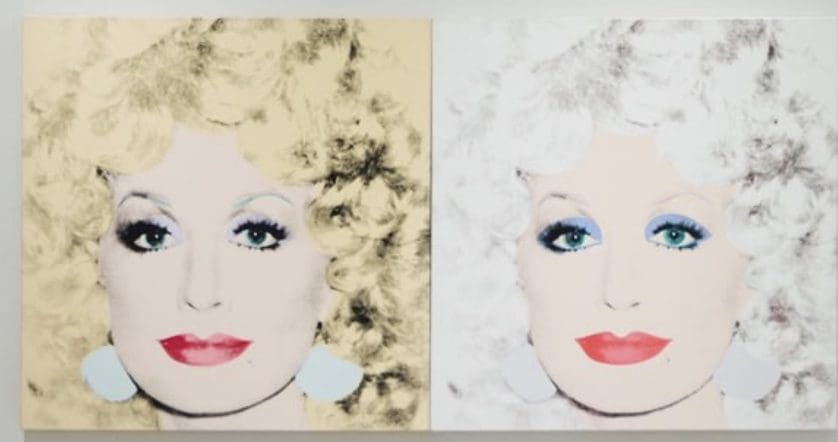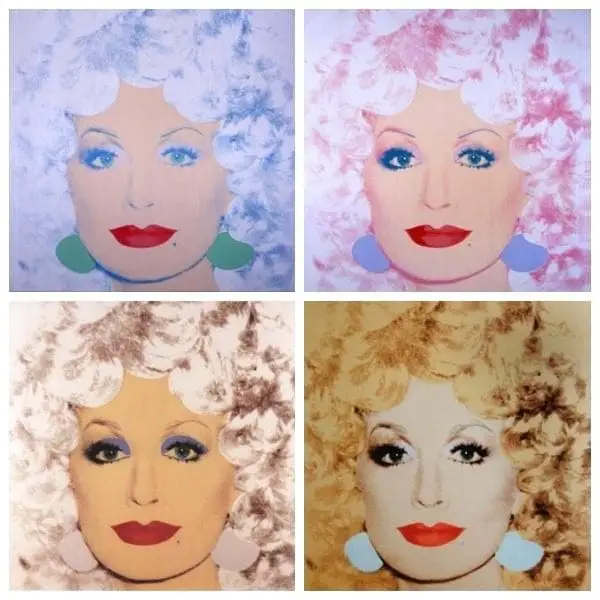The artistic oeuvre of Andy Warhol is synonymous with the exploration and celebration of fame, characterized by his acute interest in personalities who epitomized the vibrant cultural landscape of his time. His fascination found its fullest expression in his portraits, wherein he masterfully translated the persona of the celebrities he portrayed into visual masterpieces.
One strikingly memorable work is the iconic painting of Dolly Parton, created in 1985. This vibrant piece, an integral part of Warhol’s 1980s output, catapulted Dolly Parton – the undisputed Queen of Country music – into the world of pop art. With her eye-catching glamour, distinctive style, and irresistible charm, Parton was not only the perfect muse but also an embodiment of Warhol’s artistic fascination with the theatre of living.
Table of Contents
- Andy Warhol’s Iconic Dolly Parton 1985
- The Procedure: Crafting The Icon – Dolly Parton
- The Andy Warhol Technique: Beyond Just Paint
- Unraveling The Image: The Essence Behind The Icon
- Parton And Warhol – The Harmony Of Two Artistic Worlds
- Frequently Asked Questions
- Related Questions
Andy Warhol’s Iconic Dolly Parton 1985
“Dolly Parton, 1985” is an enduring emblem of Warhol’s genius – a marriage of his distinctive pop art aesthetics with the radiant personality of one of America’s most beloved performers. I
Read on as we delve into this masterpiece’s history, process, and profound implications, offering a glimpse into Warhol’s world and his unique portrayal of fame, artifice, and the spectacle of life.
Andy Warhol’s Early Art
Light-years away from the era of soup cans and Brillo boxes, the post-1960s period witnessed a transformative era in the artistic journey of Andy Warhol. His fascination for big names, bright lights, and the deceit of reinvention bloomed to its full potential during this phase.

With her hourglass figure, red lips, and big blonde hair, Dolly Parton was the sparkling embodiment of that glittering world. Always a vision of glamour, regardless of age, the Queen of Country music was the perfect sitter for Warhol’s portrait masterpiece, painted in 1985.
The Progression: Warhol’s Approach To Portraiture
Warhol’s approach to portraiture underwent a remarkable evolution during the 70s and 80s. He bid farewell to the faded newsprint portraits of his earlier years, turning instead towards an “imaginary light that makes everyone look good.”
The world of Dolly Parton, where she never appeared without a full face of makeup, seemed a mirror of this fantastical universe.
The Procedure: Crafting The Icon – Dolly Parton
Warhol maintained a highly procedural methodology when it came to his commissioned portraits. He would hire a stylist to enhance the sitter’s glamour as much as possible.
About 100 different Polaroid snapshots would be captured, allowing the client to choose the image they liked best. These works were never intended as mundane or literal portrayals. Instead, they were romantic images – representations of selves re-imagined with amplified brilliance, charm, and glitz.
Dolly Parton, 1985: An Epitome Of Warhol’s Ethos
“Dolly Parton, 1985” is one of Warhol’s masterpieces from the ’80s, epitomizing his artistic philosophy.
Dolly is depicted as nearly celestial, with pouty red lips and a halo of cotton-candied hair. Her fearless gaze, complemented by her green eyes and purple eyeshadow, conveys that life is a stage where we can manifest as anyone we aspire to be.
The Andy Warhol Technique: Beyond Just Paint
Warhol’s expert manipulation of acrylic and silk-screening technique transformed Dolly into a radiant, vibrant, and larger-than-life figure, echoing the essence of the icon herself.

The painting glows with vibrant hues of candy pinks, bright reds, and iridescent purples set against a tranquil blue backdrop, exuding the lively and exuberant persona of the country music star.
More Than A Likeness: An Attitude, A Persona
“Dolly Parton, 1985” transcends a mere likeness of its subject; it encapsulates an attitude, a lifestyle. The canvas is not just a mirror to Parton’s belief in self-fashioning but also reflects Warhol’s creative genius and his fascination with the theatre of living.
Unraveling The Image: The Essence Behind The Icon
The power of “Dolly Parton, 1985” lies not merely in the accuracy of the portrait but in the representation of a persona that both Warhol and Parton share. The Warholian ethos of becoming more than human, of becoming a brand, resonates with Parton’s understanding and embodiment of her identity.

In the meticulous portrayal of Parton’s signature style, Warhol uncovers something deeply personal – her infectious charm, her inherent joie de vivre, and her unashamed celebration of her constructed persona.
Warhol’s Ode To Fame: The Spectacle And The Allure
“Dolly Parton, 1985” is not just a portrait but a testament to Warhol’s fascination with the power of celebrity, the allure of personal branding, and the spectacle of fame. It beautifully blends
Warhol’s pop art aesthetics and Parton’s larger-than-life persona enhance the other, resulting in a canvas reverberating with the vibrant fusion of color and charisma.
“Dolly Parton, 1985” unequivocally illustrates that even as he approached the twilight of his life, Andy Warhol’s intrigue with the allure of stardom remained undiminished.
Parton And Warhol – The Harmony Of Two Artistic Worlds
When considering two iconic figures in American pop culture – Dolly Parton, the high priestess of Country music, and Andy Warhol, the maestro of Pop Art – one may not instinctively link them, yet, when their paths crossed in Warhol’s 1985 portrait of Parton, a beautiful harmony of two artistic worlds existed.

Born from modest beginnings, both Parton and Warhol rose to fame through their relentless pursuit of self-expression and unapologetic embrace of their distinct styles. While Warhol challenged conventions and made high art accessible through everyday objects and celebrity portraits, Parton revolutionized country music with her powerful storytelling and flamboyant persona.
In the creation of “Dolly Parton, 1985”, Warhol wasn’t just portraying a celebrated musician; he was encapsulating the spirit of an artist whose journey mirrored his own. Parton’s unyielding dedication to maintaining her crafted image, and her ability to shape her narrative and control how the world saw her, deeply resonated with Warhol.
Both had created larger-than-life personas, becoming brands unto themselves, not just artists.
This meeting of artistic minds – one canvas, one melody at a time -culminated in Warhol’s portrait of Parton. Warhol applied his signature silk-screening technique, capturing Parton’s characteristic big hair, beaming smile, and radiant persona through vibrant, electric hues.
At the same time, Parton’s penchant for theatricality, reinvention, and glamour echoed Warhol’s fascination with celebrity culture and the theatre of living.
“Dolly Parton, 1985” is a testament to their respective legacies – a blend of Warhol’s pop art aesthetics with Parton’s larger-than-life persona. Yet, it’s also a reflection of two journeys of self-invention and a celebration of the transformative power of art.
Parton And Warhol – New York Art Meets Nashville Country Music
This harmonic convergence of two distinctive worlds – New York’s art scene and Nashville’s country music – in “Dolly Parton, 1985 “- is a resounding tribute to the magical symbiosis between pop art and popular music.
Through the lens of Warhol and the melody of Parton, the painting reminds us of the unending allure of the spectacle of fame and the captivating theatre of life.
“Dolly Parton, 1985” is a harmonious two artistic worlds – pop art and music, New York and Nashville, Andy Warhol, and Dolly Parton.
The painting is a tribute to the transformative power of self-invention and the magic of make-believe, reminding us that life can be a stage where we are all the stars of our shows.
Anita Louise Art is dedicated to art education, great artists, and inspiring others to find and create their art. We love art that uplifts and inspires. #ArtToMakeYouSmile! #ArtToMakeYouHappy!
If you want to see any of my art, you can find out more by clicking here. If you are interested in what inspires me and my paintings, you can discover more by clicking here.
We have a free newsletter and would love you to be part of our community; you can subscribe to the newsletter by clicking here. If you have any questions, I would be happy to talk to you anytime. You can reach me, Anita, by clicking here.
Subscribe to our Anita Louise Art YouTube Channel with great videos and information by clicking here.
Join us for our podcast “5 Minutes With Art.” Spend just 5 minutes a week with us to discover and learn about great art and artists. You can find out more about our podcast by clicking here.
Frequently Asked Questions
What inspired Andy Warhol to paint Dolly Parton in 1985?
Explore the factors and influences that led Warhol to choose Dolly Parton as a subject for this iconic piece.
How did Andy Warhol approach the portrayal of Dolly Parton’s persona in the painting?
Delve into the artistic techniques and choices Warhol made to capture the essence of Dolly Parton in the painting, including his use of color, composition, and style.
What was the significance of Dolly Parton in the cultural landscape of the 1980s that appealed to Andy Warhol?
Understand the broader cultural context and the specific traits of Dolly Parton that made her a compelling subject for Warhol’s art during that period.
How did the painting impact Dolly Parton’s career and public image?
Explore the effects of being immortalized by Warhol in a pop art masterpiece on Dolly Parton’s popularity and public perception.
Were there any unique challenges or experiences during the creation of “Dolly Parton, 1985” that are noteworthy?
Uncover any interesting anecdotes, challenges, or special moments that occurred during the process of creating this particular artwork.
What distinguishes “Dolly Parton, 1985” from Warhol’s other portraits of celebrities?
Examine the distinct features, stylistic choices, or thematic elements that set this portrait apart within Warhol’s extensive body of celebrity portraits.
Did Dolly Parton have any involvement or collaboration with Andy Warhol in the creation of the painting?
Explore the extent to which Dolly Parton was involved in the artistic process and whether there was any collaboration or communication between the two artists.
How has the critical reception of “Dolly Parton, 1985” evolved over the years?
Track the changing opinions of art critics and the general public regarding the significance and impact of Warhol’s portrayal of Dolly Parton.
What is the current status and location of “Dolly Parton, 1985”?
Find out where this iconic painting is currently housed or displayed, and if it has undergone any changes in ownership or exhibition since its creation.
Related Questions
What Was The Focus Of Renaissance Art?
The focus of Renaissance art was on the classics of Greek and Rome, humanist philosophy, and the study of the human figure. Realism was also an essential part of renaissance art. The great artists of the Renaissance also became great anatomists and studied human beings.
By clicking here, you can learn more by reading What Was The Focus Of Renaissance Art?.
Why Is Van Gogh Considered Such A Great Artist?
Many things make Vincent Van Gogh unique and great as an artist. He had a great way of using color in his art, but more than that, he was an artist who set and paved the way for other artists. He changed art with his brushstroke technique, how he used color, and his design abilities. Van Gogh did all this as a self-taught artist.
By clicking here, you can learn more by reading Why Is Van Gogh Considered Such A Great Artist?.
Neoclassicism: A Harmonious Revival Of Ancient Art
Neoclassicism, or Classicism, emerged as a significant artistic movement in the 18th century in response to the ornate and frivolous Rococo style. It drew inspiration from the art and culture of ancient Greece and Rome, emphasizing simple linear design and archaeologically accurate depictions of Classical themes. With its focus on harmony, clarity, restraint, universality, and idealism, Neoclassicism left an indelible mark on the visual arts.
You can learn more by reading Neoclassicism: A Harmonious Revival Of Ancient Art by clicking here.


